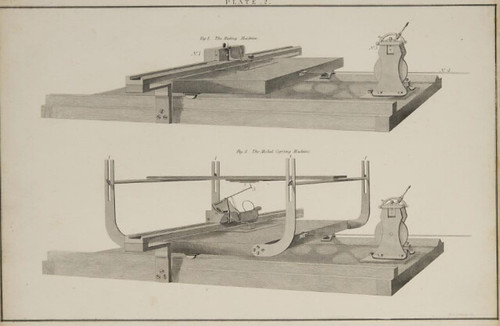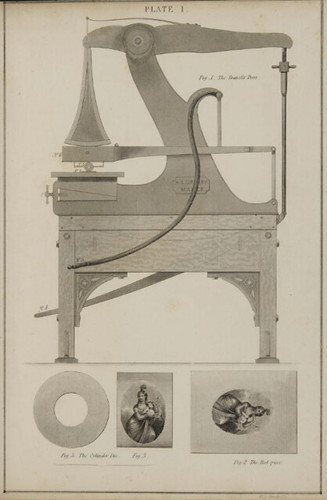
PREV ARTICLE
NEXT ARTICLE
FULL ISSUE
PREV FULL ISSUE
MORE ON MEDALLION ENGRAVING MACHINESLast week we discussed medallion engraving as a method for book illustration, a process Dick Johnson calls anaglyptography. At Dick's suggestion I obtained images from
Ormsby’s 1852 work A Description of the Process of Banknote Engraving, which has been digitized on the Newman Numismatic Portal. First, a review of the process from the Ephemera Society.
-Editor
From the The Ephemera Society of America: As a tracing arm moves over an original dimensional item (coin, bas-relief portrait, plaster model of a medal or a frame, even a sculpture), linkage to a graver reproduces the contours of the original as a continuous-line engraving. Vertical differences in the original are translated into horizontal differences (contours) in the engraving. The engraved reproduction plate is similar to a contour map, and when inked gives the strong illusion that the object is embossed. PLATE 1: The Transfer Press The Transfer Press. Figure One. - The Transfer Press, represented in a position to take up in relief, on a cylinder die, the engraving on the bed-piece. Number Two - The bed-piece, which is case-hardened. Number Three - The steel cylinder, which has been made soft by annealing. Number Four - The foot lever; by means of which the cylinder is pressed upon the bed-piece. Number Five - The hand lever, which forces the beam (number six) backward and forward. Number Six - The beam, which has a motion backward and forward. Number Seven - The screw, for elevating and depressing the bed of the machine. Figure Two. — The engraved bed-piece. — The vignette upon it is produced by concave lines cut into the steel by the hand and implements of the Artist. Figure Three. - A side and front view of the cylinder die. The vignette upon it is produced by pressure upon the bed-piece. The lines, of course, are convex, and after the dies have been case- hardened, are readily transferred again in any required spot in a Bank Plate. It will be seen that only one half of the cylinder can be used to take up the engraving, as here represented ; but an arbor, or mandrel, may be employed in a manner which will permit the engravings to be taken up on the entire periphery of the cylinder. The honor of the invention of this method of transferring engravings from one piece of steel to another, belongs to our distinguished countryman, Jacob Perkins, whose portrait may be seen on Plate Ten, Figure Ten. Transfer Presses have been made in various ways. The one represented in the engraving is, we believe, the best, and is the invention of our ingenious fellow citizen, James Bogardus, Esq. The writer has constructed one of these presses for Mr. Wellstood; one for Messrs. Rawdon, Wright, and Hatch, the well-known Bank Note Engravers, of this city ; and is now constructing one for his own use. The cost of such a press is about five hundred dollars. PLATE TWO: The Ruling, and Medallion Machines  The Ruling, and Medallion Machines. Figure One. - The Friction Ruling Machine, in common use among Engravers. It is represented in a position to execute straight lines. By the application of a brass rule, having an indented edge, waved lines can also be executed by the same machine. Number One - The sliding carriage, which has a motion backward and forward. The use of this is to mark parallel lines, with the diamond point, through an etching ground, on the Plate. Number Two - represents the plate as placed upon the bed of the machine, which has a lateral motion. The diamond point is represented as resting upon the plate. Number Three - The index, to regulate the width of the lines. Number Four - The connecting bar. Figure Two. - The Medal Copying Machine, which is made precisely like the plain ruling machine, with the exception of the four upright supporters of the medal, and a very simple tracing apparatus, which is attached to the carriage. Number One - The supporters of the medal. Number Two - The medal in a horizontal position, with the face downwards. Number Three - The steel point tracer; the uneven motion of which, in passing over the medal, conveys a corresponding lateral motion to the diamond point in passing over the surface of the plate. The medal, which is being copied, and the plate, are moved along together, by means of the index, and connecting bar. There are many kinds of ruling machines, some of which are very ingenious and complicated. Those represented in the engraving, are substantially the invention of the writer. Their simplicity and accuracy are generally commended. The writer has another machine in actual use, which is wound up like a clock, and is made to propel the ruling machine for several hours without the personal attention of any one. The weight employed is about three hundred pounds, and the fall, sixty feet. To read the complete book on the Newman Numismatic Portal, see: Ormsby's Bank Note Engraving (https://nnp.wustl.edu/library/book/522939) To read the earlier E-Sylum articles, see:  Wayne Homren, Editor The Numismatic Bibliomania Society is a non-profit organization promoting numismatic literature. See our web site at coinbooks.org. To submit items for publication in The E-Sylum, write to the Editor at this address: whomren@gmail.com To subscribe go to: https://my.binhost.com/lists/listinfo/esylum All Rights Reserved. NBS Home Page Contact the NBS webmaster 
|
